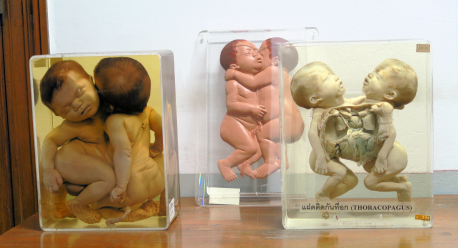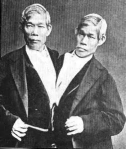Conjoined Twins
True Facts, Photos and Info
Conjoined twins are an incredibly rare and intriguing phenomenon. They are always identical and monoamniotic-monochorionic,
(sharing the same amnion and chorion).
Identical twins happen when one fertalized egg spontaneously splits into
two identical halves. So, this type of twinning is thought to occur
because of an extremely late split,
one that does not completely separate into individual fetuses.
The result is a set of twins who will have skin and even internal organs
that are fused together.
The variation can go to extremes, from easily operable to life
threatening. It is hard to imagine being attached to another person in
this way.
Under these circumstances, only 1 in approximately 100,000 to 200,000
births are actually born alive. About 50% are stillborn. Statistics
imply that 35% born alive will survive only 24 hours.
Interestingly, males are more likely to become attached, but females are
more likely to be born alive (females make up 70% of this type of twinning).
Types of Conjoined Twins
There's several different ways that twins can be conjoined. However, they can be categorized into a few types. The most common type is known as thoracopagus twins. These twins are connected at the upper portion of thier torsos.
Another classification is called thoracopagus, in which case twins share a heart. It is practically impossible to separate them and have them both survive because of how closely they are joined. Approximately 40% of twins who are conjoined fall into this category.
The next most common type, making up about 33% of cases, is known as omphalopagus. In this type of conjunction twins are joined from breastbone to waist. They almost never share a heart, but might share a liver, gastrointestinal or genitourinary functions depending on their unique body structure.
Lastly, the rarest type of conjoined twinning is craniophagus twins. These twins are joined at the head (cranium). Making up only 2%, they are truly uncommon.
Conjoined Twins of Note
The first set to garner international fame were Chang and Eng Bunker (See photo right). They were born in Thailand in 1811 (which was known as Siam at the time), though both of their parents were of mixed Chinese heritage. It is because of their roots that the term "Siamese Twins" was born. Although, the term is rarely used today and is now considered quite inappropriate. The Bunker brothers were only joined by a small piece of cartilage at the sternum and were otherwise totally independent bodies. Ironically, this type of conjoining could be taken care of easily today with simple separation surgery given current technology.
Perhaps the most endearing and spirited known today are Abby and
Brittany Hensel. These two have been featured on television several
times and their story
is truly inspiring. Though they are two completely different people with their own
unique personalities, they share much of their anatomy (See Diagram).
The thing that is most memorable
about them is how they have led such normal lives under the
circumstances. They are fun to watch and are the only surviving set of this particular type of twinning in current times. Of course, there are other types of conjoined twins who have been
around much longer and still those being born today who will
go on to lead happy, meaningful lives as well...just without all the
media attention.
So, what could be even rarer than this type of twinning? It's a phenomenon known as Fetus in Fetu or a Parasitic Twin.
Check out some more amazing photos...

Recent Articles
-
Double Duty Log Book For Twins - An easy way to keep track
Apr 11, 24 06:18 PM
Our Double Duty Log Book for Twins will help you stay on schedule, keep track of feedings and more. Save your sanity and get it all done with a twin log sheet that really works! -
37 weeks+4days and feeling huge
Sep 14, 23 12:12 PM
I am expecting a boy and girl.❤️ My belly is massive,it’s 3 times bigger than my previous pregnancy.My bum has also gotten bigger(My hubby loves it)!I -
Foods Babies Should Avoid
Jan 12, 23 06:30 PM
Foods Babies Should Avoid is a part of our feeding twins guide








Comments or Questions?
Join the conversation. We love to hear from our readers!